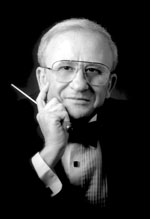|
By David Amos
 SAN DIEGO—When most people hear that there is an upcoming concert of “band music," it may bring to mind a school group of out of tune beginners, a “Sunday in the Park” old fashioned programs of Sousa, bon-bons, novelty numbers, very light music, and in general, something far removed from a true artistic musical form. SAN DIEGO—When most people hear that there is an upcoming concert of “band music," it may bring to mind a school group of out of tune beginners, a “Sunday in the Park” old fashioned programs of Sousa, bon-bons, novelty numbers, very light music, and in general, something far removed from a true artistic musical form.
But, real, quality band music is far from that. For those of us who grew up listening and being part of this rich and vibrant musical tradition, the image is quite different. Here are a few interesting facts:
Yes, a lot of band music is parades, football game halftimes, military groups, marches, orchestral transcriptions, and pop music, but since the second half of the Twentieth Century, music for winds has taken a serious turn to artistic legitimacy. Many of today’s most respected composers and those of the recent past have written for the concert band, and the music is substantial, not lightweight.
Practically all of the wind players in American orchestras first started by playing in the school band. There are high school concert bands not only in the U.S., but in other European countries which would astound you in their quality and artistry. Britain has a long legacy of concert band music. Today, however, some of the best bands in the world are found in the American universities and conservatories.
The big turnaround came in the 1950’s when the Eastman School of Music made history with its magnificent Eastman Wind Ensemble. It was conducted by the legendary, and now, late Frederick Fennell, who recorded for Mercury Records a series of long play discs which literally created a new art form within serious music.
Composers, who were already established in their careers, enthusiastically wrote for the wind ensemble, understanding very well the expressive potential of such a group, and, yes, the commercial possibilities of so many high school and college concert bands playing their music. Names that quickly come to mind include Aaron Copland, Vincent Persichetti, Norman Dello-Joio, Alan Hovhaness, Paul Hindemith, Walter Piston, Paul Creston, Morton Gould, Robert Russell Bennett, Vittorio Giannini, William Schuman, Peter Menin, Percy Grainger, and many others.
A whole new tradition was created, and the results were indeed exciting.
What makes a concert band (or wind ensemble) different from the traditional orchestra?
Go to the top of right column
|
|
Obviously, the first thing we notice is that we have no strings. No violins or violas, some works call for a single string bass and very rarely we hear of cellos being used by some composers. The majority of the sound, however is made by the winds and percussion.
The main body of the high sounds is given to the clarinet family. Instead of two or three clarinets which we find in an orchestra, we have many, playing parts one, two and three. Other clarinets are the small, squeaky E Flat clarinet, the alto, and bass clarinets. Occasionally, the contrabass clarinet. From the saxophone family, we have two altos, one tenor, and one baritone. The flutes, piccolo, oboes and English Horn (which in Britain is called a “Cor Anglais”), are the same as those in the symphony orchestra.
The brass section is also similar in that we have four horns, three trombones, and tuba. But in bands, the trumpets are augmented by their relatives, the cornets, which have a different timbre. The euphonium, or baritone horn (the closest thing to a “Wagner Tuba”), complement the lower voices. The percussion sections are usually more extensive, but the instruments are generally the same as the ones already familiar to us.
As with anything else, we find a wide margin of quality. There are good bands and some horrendous ones. There are school groups, professional concert bands, and community bands. But the sound of winds playing together, tightly, in tune, and with good ensemble and sensitivity, is rewarding. The music can be loud, or very soft.
Many composers and arrangers have taken orchestral works and transcribed them for winds only. Some turn out better than others. In turn, we also have the situation where famous compositions which were originally written for band, were adapted for a symphony orchestra, and many such pieces have become staples of the repertory all of us would recognize. Just last season, I commissioned four works which were transformed from its original band form to be played and introduced to orchestral audiences.
About fifteen years ago, I had the pleasure of conducting a recording, available today in the Naxos label, of music by Persichetti, with wind players from the London Symphony Orchestra. To my surprise, for many of these virtuoso British musicians, it was their first experience in playing and recording symphonic wind music, but the results were astounding. We recorded in the historic Abbey Road Studios in London. The technical and artistic abilities of the musicians from the U.K. are legendary, and these recording sessions include some of the most musical fun I have experienced conducting abroad.
If this is an area of music which you may not have experienced and you are ready for something fresh, I strongly recommend that you attend a program of serious, well executed concert band music. It will most certainly surprise you, and may open new horizons and pleasures which you may not have heard before.
|
|

